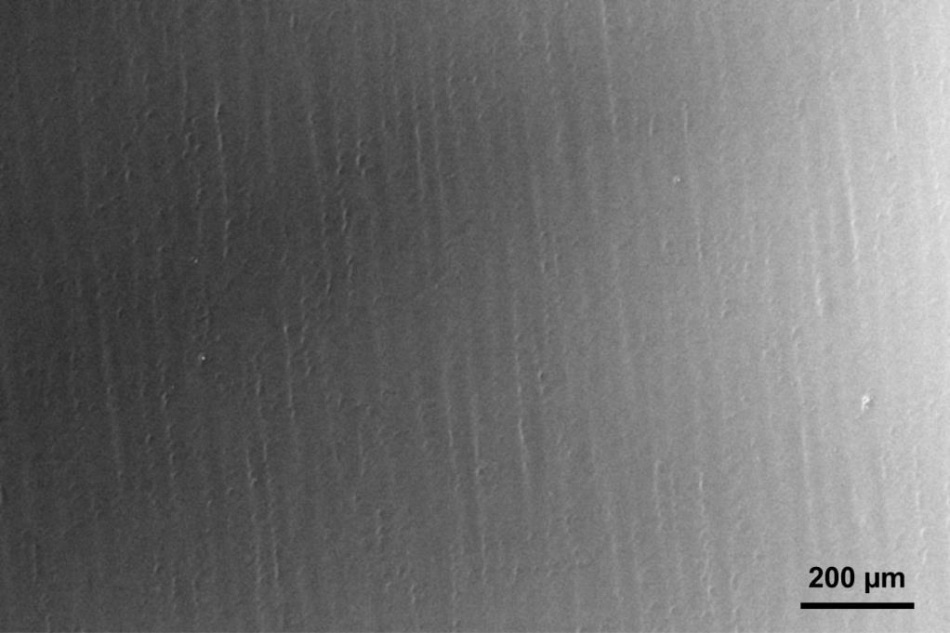Jul 4 2019
A truly single-layer (that is, adlayer-free) large-area graphene film on large-area copper foils has been reported by the research group of Director Rodney Ruoff from the Center for Multidimensional Carbon Materials (CMCM) of the Institute for Basic Science (IBS) at the Ulsan National Institute of Science and Technology (UNIST).
 A large-scale (~2.5 mm x 1.6 mm) SEM image of an adlayer-free, single-crystal graphene film on a Cu(111) foil. (Image credit: Institute for Basic Science)
A large-scale (~2.5 mm x 1.6 mm) SEM image of an adlayer-free, single-crystal graphene film on a Cu(111) foil. (Image credit: Institute for Basic Science)
Although this appears like the most recent in a series of apparently comparable declarations on single-layer graphene, this feat is different from a large number of other earlier publications because none of the earlier ones had reported truly single-layer graphene over large area. Adlayers (multilayer or bilayer regions) have always existed in such films.
IBS researchers fine-tuned the technique of chemical vapor deposition (CVD) growth by removing all carbon impurities within the copper foils on which graphene is developed. At present, CVD on metal foils (particularly copper foils) is the most propitious method for reproducible and scalable production of high-quality, large-area graphene films.
The researchers analyzed the reason for the appearance of “adlayers” in the graphene film developed on copper foils and discovered that the carbon impurities within the foil directly result in the nucleation and growth of adlayers. (Adlayers are spots in the film where 2 or 3 layers exist — that is, multilayer “patches.”)
We discovered that the commercial copper foils have ‘excess carbon’ particularly near the surface—to a depth of about 300 nm, by using time-of-flight secondary ion mass spectrometry and combustion analysis.
Dr Da Luo, Study First Author, Center for Multidimensional Carbon Materials, Institute for Basic Science
Luo further added, “From a discussion with one technical expert in Jiangxi Copper Corporation Limited, one of the world’s largest suppliers of copper foils, we learned that the carbon is embedded in the copper foil during manufacture, probably from hydrocarbon-based oil(s) used to lubricate rollers that the copper foil contacts at the high rolling temperatures.”
They could obtain an adlayer-free and thus truly single-layer graphene film by completely eliminating the carbon by performing annealing under H2 at a temperature of 1060 °C.
The IBS researchers applies the same technique and achieved an adlayer-free, single-layer and single-crystal graphene film on a single-crystal copper foil. According to Meihui Wang, one of the first authors of the study, “We thus solved two problems that have persistently been present in prior syntheses of CVD graphene films (adlayers and grain boundaries (GBs)) at one time.”
In fact, realizing complete uniformity in the number of layers across a large area (for instance, single or double layers) will help ensure a steady device performance.
Adlayer regions vary in, for example, size and density when they occur in the devices’ active regions. Apart from adlayers, GBs occur in polycrystalline graphene films developed by CVD in which graphene islands with varying crystallographic orientations combine to complete the film. The occurrence of GBs reduces carrier thermal conductivity and mobility, and brings down the mechanical strength.
Yet, the researchers were left with one intriguing property in their single-crystal films: This single-crystal graphene includes highly oriented parallel “folds” measuring a few centimeters in length, with a width of approximately 100 nm, and isolated by 20 to 50 μm. Quite similar to GBs and adlayers, it was observed that the folds considerably decrease graphene’s carrier mobility.
The researchers eliminated such scattering effects of GBs, folds, and adlayers, by patterning field-effect transistors in the region that lies between two neighboring folds and with the transistors lying parallel to the folds. In contrast to folds distributed in a quasi-random manner in the polycrystalline graphene film, the folds are extremely ordered in the large-area single-crystal graphene film. This renders it simple to develop integrated high-performance devices from the regions between the folds.
The region between two adjacent folds is ‘clean’ without any folds, adlayers, or GBs. This enabled the device to have very high electron and hole mobility. The field-effect transistors show very high room temperature carrier mobility values of around 1.0 x 104 cm2V−1s−1. Such high carrier mobility “translates” to various useful devices having high performance.”
Meihui Wang, Study Co-First Author, Center for Multidimensional Carbon Materials, Institute for Basic Science
According to Director Ruoff, “Our approach towards large area adlayer-free single crystal graphene is a breakthrough. This uniform, ‘perfect’ single layer, single crystal graphene is expected to find use as an ultrathin support material for high-resolution transmission electron microscopy imaging, and in optical devices.”
Also as an appropriate graphene to achieve extremely uniform functionalization which leads to many other applications, particularly for sensors of various types. I also would like to note that we greatly valued the strong contributions by coauthors from UNIST, from HKUST, and from SKKU.
Rodney Ruoff, Director, Center for Multidimensional Carbon Materials, Institute for Basic Science
This study was supported by the Institute for Basic Science and has been published in the Advanced Materials journal.